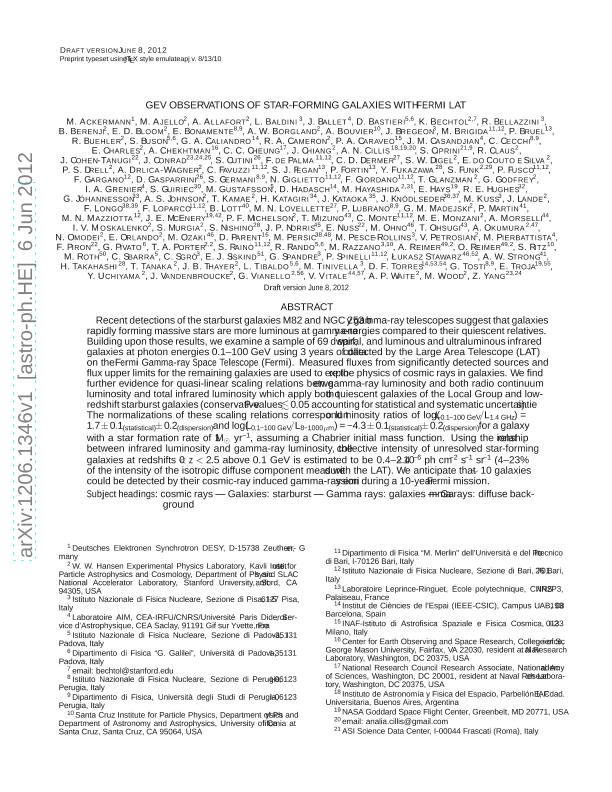Artículo
GeV Observations of Star-forming Galaxies with the Fermi large area telescope
Ackermann, M.; Ajello, M.; Allafort, A.; Baldini, L.; Ballet, J.; Bastieri, D.; Bechtol, K.; Bellazzini, R.; Berenji, B.; Bloom, E. D.; Bonamente, E.; Borgland, A. W.; Bouvier, A.; Bregeon, J.; Brigida, M.; Bruel, P.; Buehler, R.; Buson, S.; Caliandro, G. A.; Cameron, R. A.; Caraveo, P. A.; Casandjian, J. M.; Cecchi, C.; Charles, E.; Chekhtman, A.; Cheung, C. C.; Chiang, J,; Cillis, Analia Nilda ; Ciprini, S.; Claus, R.; The Fermi-LAT Collaboration
; Ciprini, S.; Claus, R.; The Fermi-LAT Collaboration
 ; Ciprini, S.; Claus, R.; The Fermi-LAT Collaboration
; Ciprini, S.; Claus, R.; The Fermi-LAT Collaboration
Fecha de publicación:
08/2012
Editorial:
IOP Publishing
Revista:
Astrophysical Journal
ISSN:
0004-637X
Idioma:
Inglés
Tipo de recurso:
Artículo publicado
Clasificación temática:
Resumen
Recent detections of the starburst galaxies M82 and NGC 253 by gamma-ray telescopes suggest that galaxies rapidly forming massive stars are more luminous at gamma-ray energies compared to their quiescent relatives. Building upon those results, we examine a sample of 69 dwarf, spiral, and luminous and ultraluminous infrared galaxies at photon energies 0.1-100 GeV using 3 years of data collected by the Large Area Telescope (LAT) on the Fermi Gamma-ray Space Telescope (Fermi). Measured fluxes from significantly detected sources and flux upper limits for the remaining galaxies are used to explore the physics of cosmic rays in galaxies. We find further evidence for quasi-linear scaling relations between gamma-ray luminosity and both radio continuum luminosity and total infrared luminosity which apply both to quiescent galaxies of the Local Group and low-redshift starburst galaxies (conservative P-values <~ 0.05 accounting for statistical and systematic uncertainties). The normalizations of these scaling relations correspond to luminosity ratios of log (L 0.1-100 GeV/L 1.4 GHz) = 1.7 ± 0.1(statistical) ± 0.2(dispersion) and log (L 0.1-100 GeV/L 8-1000 μm) = -4.3 ± 0.1(statistical) ± 0.2(dispersion) for a galaxy with a star formation rate of 1 M sun yr-1, assuming a Chabrier initial mass function. Using the relationship between infrared luminosity and gamma-ray luminosity, the collective intensity of unresolved star-forming galaxies at redshifts 0 < z < 2.5 above 0.1 GeV is estimated to be 0.4-2.4 × 10-6 ph cm-2 s-1 sr-1 (4%-23% of the intensity of the isotropic diffuse component measured with the LAT). We anticipate that ~10 galaxies could be detected by their cosmic-ray-induced gamma-ray emission during a 10 year Fermi mission.
Palabras clave:
Cosmic Rays
,
Galaxies Starburst
,
Gamma Rays
,
Diffuse Background
Archivos asociados
Licencia
Identificadores
Colecciones
Articulos(IAFE)
Articulos de INST.DE ASTRONOMIA Y FISICA DEL ESPACIO(I)
Articulos de INST.DE ASTRONOMIA Y FISICA DEL ESPACIO(I)
Citación
Ackermann, M.; Ajello, M.; Allafort, A.; Baldini, L.; Ballet, J.; et al.; GeV Observations of Star-forming Galaxies with the Fermi large area telescope; IOP Publishing; Astrophysical Journal; 755; 2; 8-2012; 164,1-23
Compartir
Altmétricas



